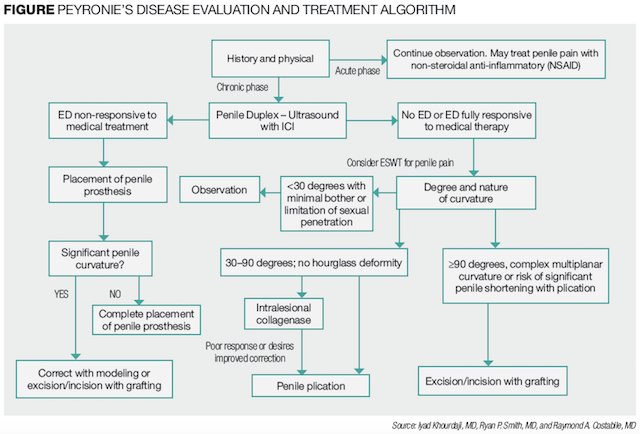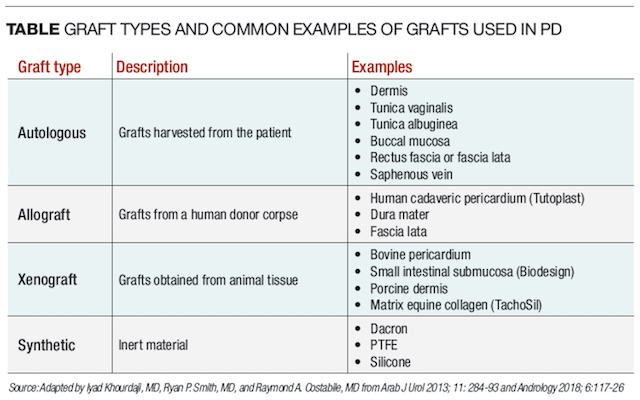Article
Streamlined management of Peyronie’s disease
Author(s):
In this article, we describe our thought processes in treating patients with Peyronie's disease, which are summarized in an algorithm.



Peyronie’s disease (PD) is believed to arise from the growth of a fibrous inelastic plaque in the tunica albuginea (J Clin Imaging Sci 2012; 2:63). The disease spectrum varies, but the physical and psychological impacts of PD can be devastating. Spontaneous resolution of PD is rare. Moreover, the full manifestation of the disease may take a significant period of time to declare itself.
Paradigms and algorithms for the evaluation and treatment of PD differ greatly among clinicians. Some standardization in practice has been achieved with creation of AUA guidelines (J Urol 2015; 194:745–53) and the Third International Consultation on Sexual Medicine guidelines on PD (J Sex Med 2010; 7:312–3;J Sex Med 2016; 13: 905–23), but adherence to these recommendations remains uncertain. The comfort level of the urologist with specific medical treatments or procedures plays a significant role in influencing approach.
To date, there are no randomized, controlled trials that prove superiority of one surgical approach over the other. Moreover, not only do the physical manifestations of PD vary greatly among patients but so does the impact of this complex disease upon quality of life. Consideration of these factors as well as the patient’s baseline erectile function are imperative in pursuing the optimal treatment strategy.
Also see: PCa-specific mortality not affected by comorbidity
In this article, we describe our thought processes in treating patients with this challenging disorder, which are summarized in an algorithm (figure).
Evaluation
The initial evaluation includes a comprehensive history and physical exam. Specific points pertaining to history include perception of erectile function, onset and duration of penile curvature, the nature and evolution of the deformity, degree of bother with PD, Peyronie’s Disease Questionnaire and Sexual Health Inventory for Men scores, and the impact of the curvature on coitus and penetration. Moreover, the presence of penile pain should also be determined to assess the status of the disease process (ie, acute or chronic phase).

Home photographs can be helpful in providing a baseline assessment of the severity of the deformity and erection quality. Smartphone apps and disposable goniometers have added to patients’ ability to track changes in curvature and progress during treatment. A thorough discussion pertaining to the consequences of PD upon quality of life should be facilitated.
The physical examination should focus on the presence, size, and location of the plaque. Note should be made of plaque calcification, which may preclude the use of certain treatment options such as collagenase clostridium histolyticum (XIAFLEX). The stretched length of the penis should also be determined with potential implications for penile prosthesis placement, appropriate counseling, and establishing patient expectations.
Prior to committing to any further workup or treatment, it is imperative to ensure the disease has entered the chronic phase. From the time of onset, our recommendation is to wait at least 6 to 12 months to make certain the plaque has stabilized. Objective assessment of PD can then be obtained utilizing penile Doppler ultrasonography with intracavernosal injection of vasoactive medication. At our institution, we most commonly inject a single 10-microgram dose of alprostadil for tumescence. However, higher doses of alprostadil or Trimix (alprostadil, phentolamine, and papaverine) may be required in some patients with severe erectile dysfunction (ED), or anxiety, to achieve adequate rigidity.
The purpose of this low-cost study is threefold. First, we are able to fully visualize the location and length of the penile plaque as well as the presence of plaque calcifications. Second, the vasoactive injection provides an assessment of erection quality. Third, with the penis erect, the full extent of the Peyronie’s deformity can be delineated with angulation quantified with the use of a goniometer. Once the full extent of PD is delineated, we can more confidently categorize a patient’s treatment options based on degree of curvature and erectile function. Establishing a patient’s goals of care (eg, reduction of curvature, assistance with pain, resolution of concurrent ED) is paramount in treatment selection.
Treatment options
Baseline erectile function significantly influences our treatment strategy. In the presence of severe ED, we advise patients to undergo placement of a penile prosthesis. Intraoperatively, curvature can be corrected via several methods. Prior to prosthesis placement, plication sutures can be placed after inducing an artificial erection with intracavernosal instillation of vasoactive agents such as alprostadil or Trimix (or saline) to fully delineate the curvature. Alternatively, once the device is placed, any significant remaining penile deformity can be corrected with modeling techniques or plaque excision/incision with or without grafting (table).
Those without ED or those with ED fully responsive to medical therapy have an array of options available depending on degree of penile deformity and goals of care. Those with curvatures less than 30 degrees can be monitored without intervention, as such deformities are unlikely to preclude adequate sexual function. Recent guidelines have suggested the use of extracorporeal shock wave therapy (ESWT) to mitigate pain symptoms associated with PD. However, preliminary data suggest an improvement in penile pain after ESWT with conflicting data regarding improvement in penile curvature (J Sex Med 2013; 10:2815–21; Urol Ann 2016; 8:409-17).
In patients suffering from simple curvatures ranging from 30 to 90 degrees, penile plication is an effective surgical approach that minimizes dissection and offers durable results. In our experience, we find that plication surgery is able to correct the majority of patients within this disease category. For this subset of patients, intralesional injection therapy with collagenase is also an efficacious management strategy for patients who elect not to undergo surgery. We have had excellent results with this therapy at our institution in appropriately selected patients.

It is important to note that patients who initially elect for intralesional management of their PD but experience a poor result or desire further correction remain surgical candidates. Penile plication surgery is a straightforward procedure with minimal risk of de novo ED or reduced penile sensation secondary to handling of the neurovascular bundle (NVB) as more commonly seen with excision and grafting procedures. Significant complications associated with plication include penile shortening, recurrent penile curvature, an unstable penis, and palpable suture knots. Patients electing to undergo intralesional collagenase should also be counseled regarding the risk of corporal fracture, which is <1% based on trial data (J Urol 2013; 190:199-207).
Read - Study: Monopolar TURP utilization on the decline
Patients with multiplanar or destabilizing deformities and/or curvatures greater than 90 degrees generally require surgical reconstruction involving plaque excision or incision with defect correction utilizing grafting techniques. This approach must also be considered in patients with curvatures less than 90 degrees in whom plication may result in considerable penile shortening. The choice of graft material is largely dictated by surgeon preference and availability of the graft. The risks of de novo ED, reduced penile sensation secondary to NVB manipulation, and recurrence of penile curvature due to graft contracture must be explicitly discussed with the patient.
A noteworthy factor to consider in the decision-making process is the cost of therapy. Thus, a thorough discussion regarding cost of intervention should be performed. Morey et al previously showed that penile plication has superior cost effectiveness compared with intralesional collagenase. According to industry data, most eligible patients with commercial insurance plans paid no co-pay for intralesional collagenase based on an analysis of 4,000 claims. For those without coverage, however, this therapy is likely cost prohibitive without industry assistance. Similarly, coverage for penile prosthesis placement is variable and frequently proves cost prohibitive for many patients (Urology Practice 2017; 4:118-25).
Conclusion
In this article, we have attempted to provide a streamlined approach to the treatment and management of PD. PD remains a challenging disease entity to treat with a potential significant impact on a patient’s physical and psychological well-being. As several treatment options are available, familiarity with each technique is crucial to not only enhance outcomes but also to provide patients with the best opportunity to make informed decisions about treatment goals. Optimizing patient selection and selecting the ideal therapy based on disease severity and concurrent ED should be the focus of future research endeavors. The importance of clarifying a patient’s goals prior to any intervention cannot be understated.
More from Urology Times:
Is favorable-risk GG2 prostate Ca suitable for active surveillance?
Progress on penile transplant moves forward
Penile transplant guidelines missing in action

Subscribe to Urology Times to get monthly news from the leading news source for urologists.
















